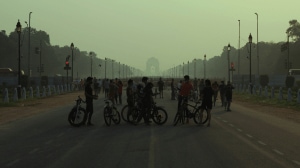30-ft wall of water turned dunes into death traps
In the early hours of Monday, after it poured more than 700 mm in 36 hours, villagers of Sar Ka Par here decided to abandon their homes for a safe place.

In the early hours of Monday, after it poured more than 700 mm in 36 hours, villagers of Sar Ka Par here decided to abandon their homes for a safe place.
Just as they were fleeing the village, a priest from the local temple exhorted them to take shelter in the temple instead as the shrine was blessed. While most of the villagers fled, nearly 40 people decided to stay back. In two hours flat, say eyewitnesses, all of them, including the priest, were swept away. Today, the entire village is submerged in more than 10 feet of water, with not a trace of the temple.
“Ram bhi hum se rooth gaya hai (even god has turned his back on us),” says Shahid Bhai, one of the villagers who ignored the priest’s pleas and scampered to a nearby hill. They were rescued by the army 36 hours later after one of them managed to make a call from his cell phone.
The pessimism is justified. For, almost everything that the people of Thar depended on for their survival has turned against them. Even the sand dunes, the desert’s symbol of beauty and resistance, have wreaked havoc. Under the force of a 30-feet high wall of water that swept across the desert after it rained non-stop, many dunes have shifted, leaving behind craters in the ground.
“Some of these dunes have occupied the low-lying areas in the desert. We fear that dozens of people may be trapped under them,” says Bhanwar Lal Chaudhary, whose NGO Lok Kalyan Parishad is running relief camps in the affected areas.
Kawas, the 5000-strong village that was till recently the centre of attraction for real estate buyers, is one of the places that could have been replaced by sand dunes, says Chaudhary.
Apart from Kawas, two more big villages—Bandra and Sar Ka Bas—are still under water. “The height of the water standing in these villages is 10-20 feet,” says Abhinav Dutt, part of a relief team organised by NGO Child Relief and You (CRY).
But the extent of damage to these villages would perhaps never be known. Geologists say the villages are spread on huge reserves of gypsum, which would not soak water for months. Since there are no drains in the village, experts are planning to drill holes in the thick gypsum layer so that water recedes from the area. This may take several days experts say.
While relief workers are fanning out through the desert, villagers complain that the government is visible nowhere. Shahid, who is currently at a relief camp organised by social workers at Bayatu, says he has not seen anybody from the local administration since he was rescued with other villagers by the army three days ago. “Thousands of dead animals are floating in the water. But people are forced to drink the same water because there is no other option,” he says.
The army, which has a huge base on the border, is their only source of hope. “They are running a well-organised operation. If not for the army, the death toll would have run into thousands,” says Hakam Singh who was saved with 60 others by the army from Malva village.






- 01
- 02
- 03
- 04
- 05

























